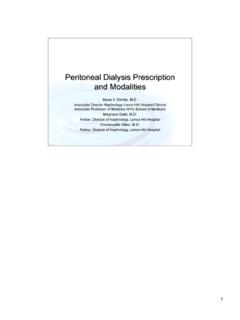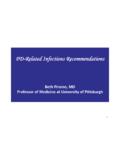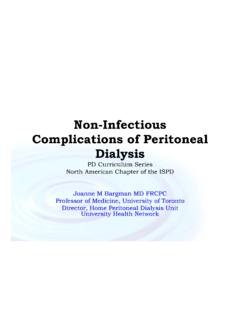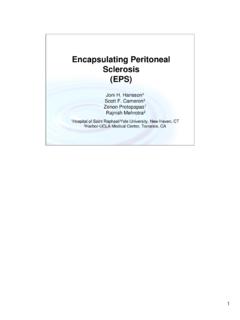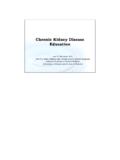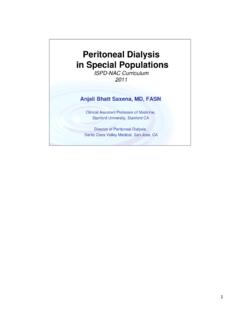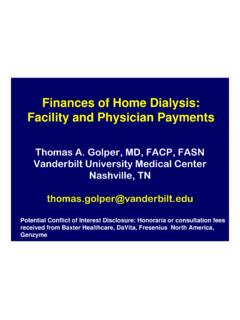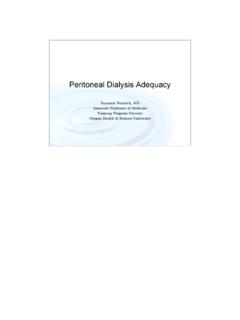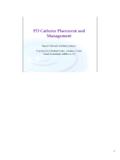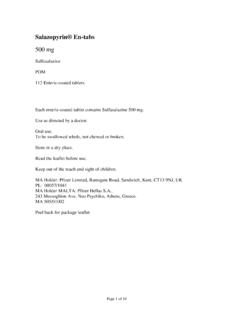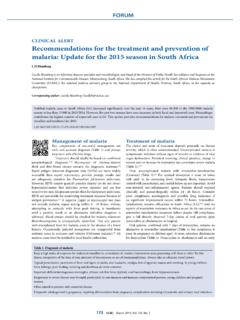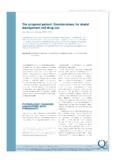Transcription of NUTRITIONAL REQUIREMENTS OF PERITONEAL …
1 NUTRITIONAL . REQUIREMENTS OF. PERITONEAL dialysis . J. Kevin Tucker, Brigham and Women's Hospital Massachusetts General Hospital Outline Prevalence of protein-energy wasting in PERITONEAL dialysis NUTRITIONAL predictors of outcomes in PERITONEAL dialysis Albumin as a predictor of outcomes in PERITONEAL dialysis Assessing NUTRITIONAL status in PERITONEAL dialysis patients Protein and energy intake in dialysis patients Metabolic acidosis NUTRITIONAL interventions Questions Suggested readings Nomenclature The term protein-energy wasting will be used for the commonly encountered clinical problems of protein malnutrition and energy malnutrition. This nomenclature has been suggested by an expert panel of the International Society of Renal Nutrition and Metabolism.
2 Fouque D et al, Kidney Int 2008; 73: 391-398. Prevalence of protein-energy wasting How common is protein-energy wasting in dialysis patients? Estimates of protein-energy wasting among dialysis patients vary. Average is about 40%. Most have mild to moderate protein-energy wasting 6-8% have severe protein-energy wasting Mehrotra and Kopple, Annu Rev Nutr 2001; 21: 343-70. How does NUTRITIONAL status compare in HD versus PD? Few studies have compared the NUTRITIONAL status of HD compared to PD. Using five objective and subjective nutrition- related indicators (percentage IBW, serum albumin, percentage unplanned weight loss, appetite and intake, GI symptoms), Park and colleagues classified a group of Korean HD and PD patients as well nourished, mildly malnourished, moderately malnourished, or severely malnourished: NUTRITIONAL status of PD and HD.
3 Patients PD HD. Total 51 169. Well-nourished 34 (67%) 139 (82%). Mildly 8 (15%) 24 (14%). malnourished Moderately 7 (14%) 6 (4%). malnourished Severely 2 (4%) 0. malnourished 33% of PD patients were malnourished compared to 18% of HD patients. Park YK et al, J Ren Nutr 1999; 9: 149-56. NUTRITIONAL parameters with emphasis on albumin NUTRITIONAL parameters as predictors of outcomes In both chronic hemodialysis and PERITONEAL dialysis , NUTRITIONAL status is associated with outcomes. In PERITONEAL dialysis , each of the following NUTRITIONAL parameters has been associated with outcomes: NUTRITIONAL parameters predictive of outcomes in PD. Low serum albumin levels Reduced urea nitrogen appearance Decreased edema free/fat-free mass Low serum creatinine Creatinine appearance rates Poorer overall protein and energy NUTRITIONAL status as assessed by subjective global assessment Decreased total body nitrogen content Mehrotra and Kopple, Annu Rev Nutr 2001; 21: 343-70.
4 Albumin as a marker of NUTRITIONAL status Albumin by itself is not a good Easily measured predictor of NUTRITIONAL status: Influenced (negatively) by One of the monthly inflammation labs routinely Tends to go down as measured by dialysis inflammatory markers ( , CRP, IL-6, ferritin) go up providers Influenced (negatively) by Used by dialysis albuminuria and PERITONEAL albumin losses providers as a quality Affected by hydration indicator status Han DS et al, Adv Perit Dial 1996; 12: 288-292. Albumin and CAPD Technique survival Blake et al, J Am Soc Nephrol 1993; 3: 1501-10. Albumin and SGA in the CANUSA Study Variable Relative Mortality Risk 95% Confidence Interval Age (per year) IDDM CVD Country (USA) Serum albumin ( 1 g/L) Kt/V ( units/wk) SGA ( 1 unit) CANUSA PERITONEAL dialysis Study Group, J Am Soc Nephrol 1996; 7-198-207.
5 Albumin and SGA in the CANUSA Study A 1-gram/L lower serum albumin concentration was associated with a 6%. increase in relative risk of death. A 1-unit lower SGA score was associated with a 25% increase in the relative risk of death. Assessing NUTRITIONAL status Subjective Global Assessment (SGA). An inexpensive and reproducible instrument for assessing the NUTRITIONAL status of PD patients Gives a global score of protein-energy wasting An important parameter in SGA is anorexia Independent predictor of mortality in HD. patients Nephrol Dial Transplant 2005; 20 [Suppl 9]:28-33. Enia G et al, Nephrol Dial Transplant 1993; 8: 1094-1098. Protein equivalent of total nitrogen appearance (nPNA).
6 The rate of urea nitrogen appearance in dialysate and urine is assumed to closely reflect dietary protein intake: the protein equivalent of nitrogen appearance (PNA). In PD patients, PNA is estimated from direct measurement of urea nitrogen in dialysate and urine PNA is then normalized to a standardized body weight (nPNA) based upon age, sex, body weight and height Mehrotra R and Kopple JD, Annu Rev Nutr 2001; 21: 343-70. Limitations of nPNA. Approximates dietary protein intake only when the patient is in nitrogen equilibrium or steady state Will change in anabolic or catabolic situations and in circumstances of marked variation in protein intake May overestimate dietary protein intake when the protein intake is < 1 g/kg/day Normalizing PNA to body weight can be misleading in obese, malnourished, and edematous patients Enia G et al, Nephrol Dial Transplant 1993; 8: 1094-10.
7 Anthropometry Anthropometry quantifies body mass and provides a semiquantitative estimate of the components of body mass, particularly bone, muscle, and fat compartments Inexpensive and easily performed Can be used as an adjunct to clinical assessment of NUTRITIONAL status Estimates of lean body mass and fat mass agree reasonably well with DEXA. Anthropometry Parameters assessed: Body weight Height Skeletal Frame Size Skin-fold thickness Percentage of body mass that is fat Percentage of usual body weight Percentage of standard body weight Body mass index Hand strength Functional test of NUTRITIONAL status Inexpensive and simple to perform Correlates well with other tests of NUTRITIONAL status Demonstrated to predict outcomes in PD.
8 Patients Wang AYM et al, Am J Clin Nutr 2005; 81: 79-86. Heimburger O et al, Am J Kidney Dis 2000; 36: 1213-1225. Dual Energy X-Ray Absorptiometry (DEXA). Reliable, noninvasive method to assess the three main components of body composition Fat mass Fat-free mass Bone mineral mass and density Less influenced by hydration Superior precision and accuracy compared to anthropometry More expensive to perform NKF/K/DOQI Assessment and Monitoring Recommendations Measure Minimum Frequency of Measurement Serum albumin Monthly % of usual post-drain body weight Monthly % of standard (NHANES II) body Monthly weight Subjective Global Assessment Monthly Dietary interview and/or diary Every 6 months nPNA Every 3-4 months Anthropometrics As needed DEXA As needed Am J Kidney Dis 2000; 35 (6) Suppl 2: S17-S104.
9 Dietary protein intake (DPI). The recommended dietary protein intake for PERITONEAL dialysis patients is g/kg body weight/day (K/DOQI). Nitrogen balance studies have shown that DPI of g/kg/day or greater is almost always associated with neutral or positive nitrogen balance. CAPD patients average about 8 g/day of PERITONEAL protein loss Higher during episodes of peritonitis Kopple JD, Am J Kidney Dis 2001; 38 (4) Suppl 1: S68-S73. Dietary Protein Intake: A. Dissenting View There is a linear relationship between protein and phosphorous intake. High protein diets are frequently associated with hyperphosphatemia. Phosphate clearance is similar to creatinine clearance In anuric patients, maintaining normal phosphorous levels will be difficult with the recommended DPI.
10 Uribarri J, Am J Kidney Dis 2001; 37: 1313-1318. Dietary energy intake Energy intake of patients on PD represents the sum of dietary intake and glucose absorption from dialysate (See slides 26-27). In CAPD patients with normal PERITONEAL transport capacity, about 60% of the daily dialysate glucose load is absorbed: about 100-200 grams/24 hours K/DOQI recommendations: 35 kcal/kg/day for patients younger than 65. 30-35 kcal/kg/day for patients older than 65. Nephrol Dial Transplant 2005; 20 [Suppl 9]:28-33. Heimberger O et al, Kidney Int 1992; 41: 1320-1332. Glucose absorption from dialysate Glucose absorbed from dialysate can be estimated using the following equation: Glucose absorbed (g/day) = (g/day) -43.
